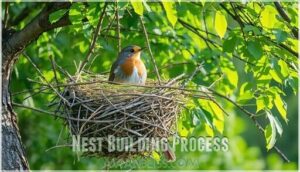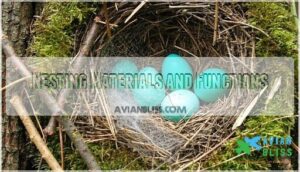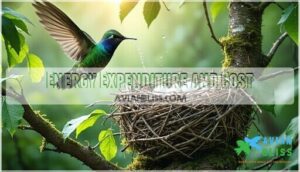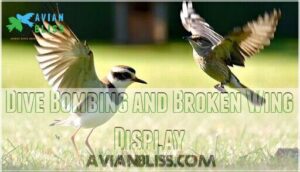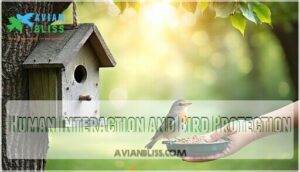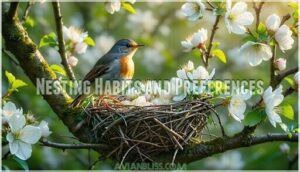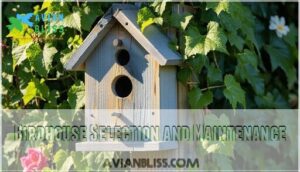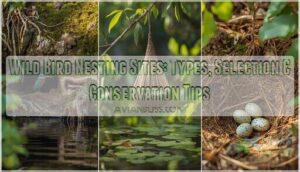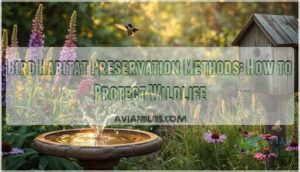This site is supported by our readers. We may earn a commission, at no cost to you, if you purchase through links.
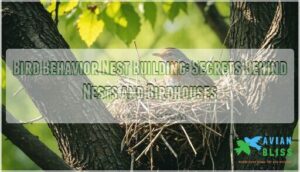
Birds carefully select materials—twigs, grass, mud, even spider silk—based on their species’ instincts.
You’ll notice they weave, stack, and mold these materials with remarkable precision, often returning to the same spot year after year.
Some birds, like bowerbirds, even decorate their nests to attract mates.
This complex process isn’t just random; it’s a carefully choreographed dance between instinct and adaptation.
The nest must withstand weather while protecting vulnerable eggs and chicks.
Nature’s little contractors have much to teach us about efficient, sustainable building techniques, using natural materials and adapting to their environment with remarkable precision.
Table Of Contents
- Key Takeaways
- Bird Nesting Basics
- Nesting Behaviors and Defense
- Human Interaction and Bird Protection
- Nesting Habits and Preferences
- Birdhouse Selection and Maintenance
- Frequently Asked Questions (FAQs)
- What type of behavior is a bird building a nest?
- How do you get rid of a bird that keeps building a nest?
- What kind of behavior is a bird building a nest?
- What do birds look for when building a nest?
- What does it mean when birds make nests around your house?
- Do birds sleep in the nest they are building?
- How do birds select materials for nests?
- What influences bird nest height choices?
- How do environmental conditions affect nest design?
- Why do birds use feathers in nests?
- Conclusion
Key Takeaways
- You’re witnessing true animal architecture when birds build nests, as they carefully select materials like twigs, grass, mud, and spider silk based on their species’ instincts and environmental needs.
- When you notice birds becoming protective with warning calls, posture changes, or dive bombing, you’re seeing nest defense behaviors that help them guard their young from predators and disturbances.
- You’ll help birds thrive by respecting their territories and minimizing disturbances, which reduces stress during nesting season and complies with bird protection laws like the Migratory Bird Treaty Act.
- You can support successful nesting by providing appropriate birdhouses with proper dimensions, untreated wood construction, suitable entry holes, and regular cleaning maintenance after breeding seasons.
Bird Nesting Basics
Birds build nests with remarkable skill, using natural materials to create safe spaces for their eggs and hatchlings.
Remarkable architects of nature, birds craft nests with precision, blending skill and instinct to shelter their eggs and raise their young.
You’ll notice how much time and energy they invest, proving just how essential nests are for survival.
Nest Building Process
Birds take a clever, almost architect-like approach to nest building.
Crafting nests with meticulous skill, birds demonstrate nature’s architecture, showcasing clever design, ensuring safety, warmth, and seamless blend with their environment.
They scrupulously select and gather nest materials—twigs, grass, or even spider silk—crafting sturdy structures through refined nest building techniques.
The building timeline can vary, but their commitment shines as they engineer intricate nest architecture.
Nest construction often incorporates natural camouflage, blending perfectly with surroundings, ensuring safety and warmth for eggs and future nestlings.
Nesting Materials and Functions
Creating a sturdy, cozy home for chicks is no small feat.
Birds select nesting materials with purpose—they provide warmth, protect fragile eggs, and even aid in nest sanitation.
- Twigs and moss for structure and nest insulation.
- Spider webs to bind materials, adding flexibility.
- Dried grasses for camouflage materials, hiding nests from predators.
Many birds also use specialty nesting products to enhance their nests.
Avian architecture is truly remarkable, with birds using these materials to create a cozy home, and some even utilizing specialty nesting products for added benefits, making their nests a sturdy haven.
Energy Expenditure and Cost
In the grand plan of raising young, energy matters big time.
Nest building behavior burns calories—carrying bird nesting materials isn’t just for fun!
Between foraging costs, defense energy, and nest thermoregulation, parents juggle it all.
Parental investment directly ties to breeding success.
Too much nest effort? Less energy for chicks.
Balanced bird energy expenditure means thriving offspring and better bird breeding success.
Birds strategically select locations, considering shelter from predators.
Nesting Behaviors and Defense
You’ll notice birds are surprisingly protective of their nests, using clever signals and bold behaviors to guard their young.
From dramatic dive bombing to the convincing broken wing display, these tactics keep predators—and sometimes people—at bay.
Warning Signs and Signals
When nesting season rolls around, birds alert you to potential threats with some fascinating behaviors.
You’ll notice subtle posture changes, sharp vocalizations, or even material gathering near their lofted sanctuaries. These little guardians mean business regarding their nests.
- Posture Changes: Birds appear puffed-up or freeze in place to ward off intrusions.
- Vocalizations: Warning calls, like loud chirps or scolding tones, signal predators—and sometimes humans—to back off.
- Repeated Visits and Sounds: Unusual sounds or relentless trips to one spot mean nesting activity is nearby, so tread lightly!
Understanding bird behavior territorial defense helps explain these actions. Respect these hints to keep nesting birds stress-free.
Dive Bombing and Broken Wing Display
Sometimes, birds put on quite a show to protect their nests.
Dive bombing, used by colonial species and backyard birds, aims to scare off predators or even unsuspecting humans. Meanwhile, solitary plovers rely on the broken wing display, a clever mimicry where they feign injury to lead danger away from nests.
Here’s a quick guide:
Defense Tactic Examples Purpose
Nest defense is pure bird brilliance—safety’s their priority!
Human Interaction and Bird Protection
When you respect bird territories and give them space, you’re helping protect their young and reduce stress during nesting season.
By staying mindful of their behaviors and following simple guidelines, you’ll guarantee both birds and people can peacefully coexist.
This approach ensures that both species can thrive together, with respect for each other’s space.
Respecting Bird Territories
Birds guard nesting territories like tiny warriors, and respecting their space helps everyone coexist.
Observe warning signs—like loud calls or swooping—and avoid encroachment. Minimize disturbances by keeping a respectful distance from nests, especially during nesting behavior.
Providing space can reduce stress for these feathered parents, and these coexistence strategies guarantee bird defense efforts aren’t wasted and help protect their young during bird nesting season.
Minimizing Disturbances and Stress
It’s vital to minimize bird disturbance to protect nests and guarantee thriving young.
Observe quietly and stay away from bird nesting sites.
To help reduce stress:
- Keep pets indoors or leashed near nesting birds.
- Avoid scent trails close to nests.
- Use native plants for cover.
- Practice responsible birding protocols.
- Avoid repeatedly approaching nests to prevent nest abandonment.
Remember to maintain safe distances from birds to minimize stress and protect nests with thriving young.
Legal Considerations and Regulations
Respect bird territories because legal boundaries are firm.
The Migratory Bird Treaty Act (MBTA) makes messing with nests under federal law a big no-no.
Nest disturbance is only legal pre-eggs.
Protected species need extra care—no DIY nest relocation allowed!
Timing exclusion matters; skip nesting season entirely.
Federal and state laws guarantee bird conservation thrives.
Play safe, follow bird protection laws and respect legal boundaries to ensure federal law is upheld.
Nesting Habits and Preferences
You’ll notice birds are surprisingly picky regarding choosing where to nest, often factoring in safety, resources, and the surrounding environment.
Each species has its own unique preferences, from high tree branches to ground-level hideouts, making nest selection a fascinating and essential process.
Nest Site Selection and Location
Finding the perfect bird nesting location is all about balancing safety and resources.
Nest site selection considers several factors:
- Habitat availability – Dense shrubs or high trees offer cover.
- Nest concealment – Hidden spots protect against predators.
- Site fidelity – Many return to familiar nesting sites.
- Microclimate factors – Shade or sunlight influences comfort.
- Competition avoidance – Quiet areas reduce rival interruptions.
These factors are crucial for the birds to find a suitable location to build their nests, ensuring the survival and success of their offspring.
Environmental Factors and Nesting
Regarding bird nesting habits, the environment plays a huge role.
Climate change shifts timing, habitat loss reduces options, and pollution impacts even nesting materials.
Urbanization effects make bird nesting locations unpredictable, while resource availability influences nest site selection.
These factors shape nest building techniques as birds adapt to survive in your rapidly changing world, reminding us how fragile these ecosystems are, and the importance of understanding environment.
Species-Specific Nesting Requirements
Different bird species have unique nesting requirements. Habitat specificity plays a big role—duck nests often hide near water, while robins prefer open spaces.
Regional variations impact dietary needs; some birds rely on local berries or insects. Clutch size varies too, from a few eggs to large broods.
Many bird species use nest-building techniques like clever nest camouflage, ensuring safety from predators. Proper placement strategies can greatly increase the chances of attracting native species.
Observe closely the unique nesting habits and regional variations to better understand how to support local bird populations.
Birdhouse Selection and Maintenance
In the case of birdhouses, picking the right size and design can make all the difference for your feathered guests.
Regular cleaning and proper placement keep your birdhouse inviting and safe, helping birds thrive in their new home.
Choosing The Right Birdhouse
Choosing the right birdhouse means thinking like your feathered visitors.
Match birdhouse size to the species, and opt for untreated wood—no metal or plastic, please!
Entry holes should fit, keeping rivals and pests out.
Consider birdhouse size dimensions to guarantee a comfortable fit.
Add proper ventilation needs and weather protection, like sloped roofs.
Predator guards help keep nests safe, while simple designs mimic natural nesting spots, prioritizing comfort over curb appeal, ensuring a safe and natural nesting spot.
Mounting and Placement Considerations
Mounting your birdhouse at the right height deters predators and encourages safe nesting spots.
Aim for shade or partial sun exposure—no bird enjoys a broiling nest.
Choose weather-protected areas to shield from rain or strong winds.
Install a nest cam nearby for observation without intrusion, and make certain the mounting location aligns with natural bird nest site selection, promoting comfort and security for feathered tenants.
Cleaning and Maintenance Tasks
Keeping birdhouses cozy and clean is your responsibility! Regular cleaning helps maintain nest sanitation and supports healthy bird nesting behavior.
Follow these tips:
- Clear old nesting materials after fledglings leave.
- Scrub interiors with a mild soap, then rinse thoroughly.
- Inspect for damage and repair nests as needed.
- Replace rotted wood, guaranteeing weatherproofing nests.
- Monitor for parasites—prevention guarantees safe nestling care.
Consider purchasing specialized cleaning products for superior hygiene. Your efforts make birds feel right at home!
Frequently Asked Questions (FAQs)
What type of behavior is a bird building a nest?
Like architects drawing blueprints for their dream home, birds exhibit reproductive behavior when building nests. You’ll notice they’re gathering materials, creating a safe haven for their eggs and future offspring.
How do you get rid of a bird that keeps building a nest?
Wait until nesting season ends before removing empty nests.
Install barriers like mesh or spikes in problem areas.
You can’t legally disturb active nests of native birds, so prevention before they build is key.
What kind of behavior is a bird building a nest?
Nest building is a reproductive behavior where birds collect materials to create safe homes for their eggs and young.
You’ll notice them gathering twigs, grass, or other items repeatedly during spring and summer.
What do birds look for when building a nest?
Birds seek secure locations with protection from weather and predators.
You’ll notice them gathering twigs, grass, moss, and soft materials.
They’ll choose spots with good visibility and access to food sources.
What does it mean when birds make nests around your house?
You’ve hit the jackpot! When birds nest around your house, they’re identifying your property as a safe haven with suitable shelter and nearby food sources for raising their young.
Do birds sleep in the nest they are building?
Most songbirds don’t sleep in nests they’re building.
They use nests primarily for raising young, while adults roost in nearby trees or shrubs.
Only females of certain species will sleep there during incubation periods.
How do birds select materials for nests?
When it comes down to brass tacks, birds choose materials based on availability and function.
You’ll notice they’re selecting twigs, grass, moss, feathers, and even spider silk for strength, insulation, and camouflage.
What influences bird nest height choices?
You’ll find that predator avoidance primarily influences nest height choices, along with habitat type, species size, available materials, and competition.
Weather protection and food proximity also play vital roles in this strategic decision.
How do environmental conditions affect nest design?
Like architects responding to their surroundings, birds adapt nest designs to weather, predators, and available materials.
You’ll notice thicker insulation in cold regions and cooling ventilation in hot climates, ensuring chick survival year-round.
Why do birds use feathers in nests?
Birds incorporate feathers into their nests for insulation and comfort.
You’ll notice they use soft down feathers to create a cozy microclimate that protects eggs and nestlings from temperature fluctuations, keeping their young warm and secure.
Conclusion
As you observe bird behavior nest building in your yard, you’ll discover a world of instinct and ingenuity right before your eyes.
By providing suitable materials, respecting territories, and maintaining proper birdhouses, you’re supporting these remarkable architects.
Whether you’re watching a robin weave twigs or a swallow shape mud, understanding bird behavior nest building enriches your connection to nature.
These tiny engineers remind us that sometimes the most impressive construction happens on the smallest scale.

